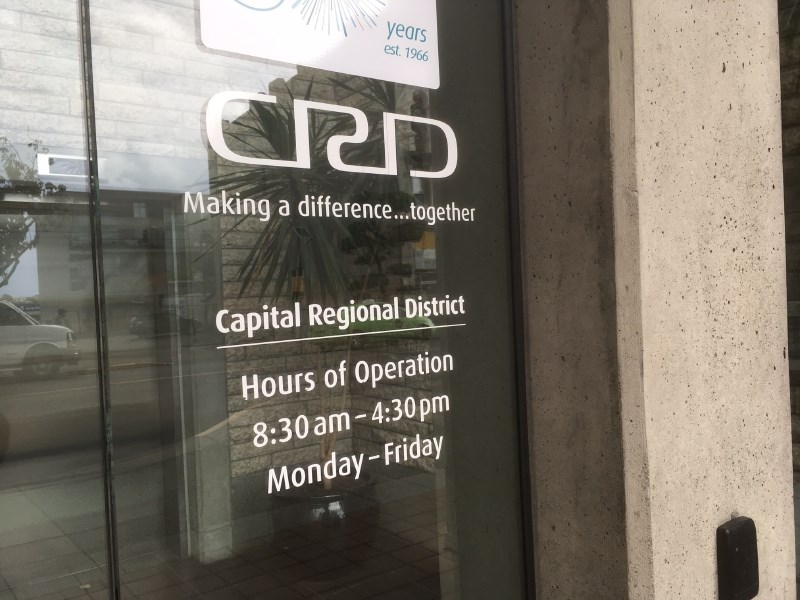The Capital Regional District needs to hire more staff to keep up with Greater Victoria’s hot economy, say senior staff.
More than 20 full-time equivalents would be hired if plans proposed by senior staff are approved by CRD directors.
The additional staff is needed to keep up with what’s being described as “a surge of development activity and population growth.”
Direct and indirect impacts of that growth “have led to a need for additional short- and long-term capital investment, various infrastructure improvements, and upgrades to maintain service levels within the region,” says a report from chief financial officer Nelson Chan.
“The economy is a big part of it. It’s going gangbusters,” Chan said in an interview. One third of all construction jobs in the province are in Greater Victoria, he noted.
“That fact is that everything that the CRD supports has been growing faster than the CRD in the last five years.”
The CRD, with a $500-million annual budget, has 571 full-time and about 500 part-time or auxiliary employees.
Costs for the proposed hiring still need to be calculated.
Using a rough estimate of $90,000 in annual salary and benefits per new employee, the hirings could cost an additional $2 million a year.
The CRD paid $46.8 million in salaries in 2016, of which $23.8 million went to employees making more than $75,000 a year.
The proposal for more hiring says a surging economy is stressing the CRD’s ability to manage systems such as water supply and solid waste management.
On the positive side, the increased development activity is bringing in additional revenue, particularly at Hartland Landfill and through wholesale selling of water, the report says.
How all those hires would affect taxes is difficult to say. CRD costs vary from municipality to municipality, and from electoral area to electoral area, depending on what services they participate in.
As well, some of new hires, as in the case of CRD water, would be paid directly through utility charges. In other cases, such as with the 4.6 employees hired when the CRD assumes operation of Salt Spring Island’s Rainbow Road Indoor Pool, costs would be borne only by Salt Spring Island residents and recovered through a combination of savings, fees and charges for programs.
In other cases, costs could be offset by retirements or changes to how staff are deployed.
Langford Mayor Stew Young, who has no love for the CRD, said it should consider a core service review with a view to eliminating services it no longer needs before hiring more staff.
“It’s a large organization,” Young said. “The CRD does not need to get any bigger. They need to manage what they have.”
Departments in line for new hires include: financial services, asset and risk management, information technology, integrated water services, waste-water services, watershed protection, parks and environmental services, planning and protective services and housing.
CRD operational spending in 2017 increased by nine per cent from 2016.
- - -
Proposed Capital Regional District hiring in 2018 includes:
Salt Spring Island
• 4.6 full-time equivalent (FTE) to assume Rainbow Road Indoor Pool operations from private contractor
Human resources
• Two FTE for centralized oversight of regulatory and legal responsibilities
Finance and technology
• Two four-year positions in support of sewage treatment project
• One FTE in financial services
• One FTE in asset and risk management to support planning for essential services during an emergency
• One FTE in information technology (security) and one FTE to meet growing IT requirements
Integrated water services
• One FTE for a supervisor of operations for sewage treatment plant
• 0.5 FTE for Magic Lake Estates water and sewer service operations
• Two FTEs, one for technical support engineer and one for GIS/drafting technician for sewage treatment project
• One FTE to maintain database in Juan de Fuca water distribution service
• One FTE in watershed protection for public engagement for resource planning projects, hydrology field monitoring and public tour expansion
Parks and Environmental services
• 0.5 FTE for a demolition waste technician at the Hartland Landfill
• 0.3 FTE for a climate action program assistant
• 0.5 FTE for an ecosystem biologist for regional management of invasive species
• 0.6 FTE to address increased regulatory requirements related to tracking and monitoring contaminated sites
• One FTE for a drinking water sampling technician
• Two four-year FTEs as project leads for integrated resource management
Planning and protective services
• 0.5 FTE for parks bylaw enforcement with a focus on dog management
• One FTE for a tenant engagement pilot projectt



